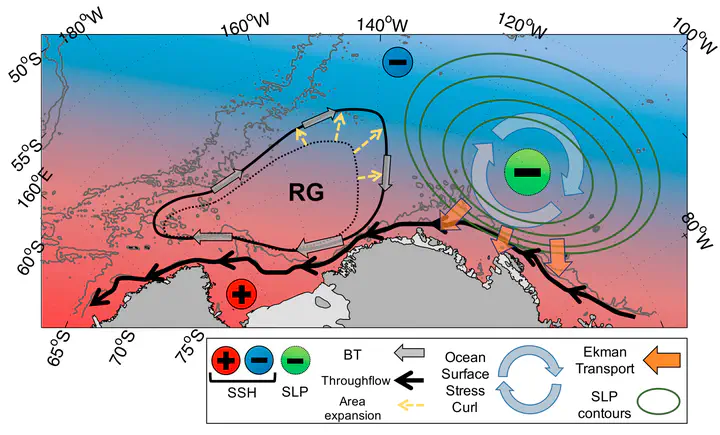Variability of the Ross Gyre, Southern Ocean: drivers and responses revealed by satellite altimetry
 Schematic of the processes involved on the expansion and intensification of the Ross Gyre (RG) and throughflow. A negative sea level pressure (SLP) anomaly is formed north of the Amundsen Sea Embayment, which generates a cyclonic circulation over the region. This lowers sea level to the north via Ekman dynamics, allowing a northeastward migration of the RG outer boundary. Further, a westward surface stress anomaly is created over the gyre’s southern boundary, accelerating the RG. Southward Ekman transport piles water up over the continental shelf, increasing sea surface height (SSH) and the cross-shelf pressure gradient and thereby intensifying the throughflow.
Schematic of the processes involved on the expansion and intensification of the Ross Gyre (RG) and throughflow. A negative sea level pressure (SLP) anomaly is formed north of the Amundsen Sea Embayment, which generates a cyclonic circulation over the region. This lowers sea level to the north via Ekman dynamics, allowing a northeastward migration of the RG outer boundary. Further, a westward surface stress anomaly is created over the gyre’s southern boundary, accelerating the RG. Southward Ekman transport piles water up over the continental shelf, increasing sea surface height (SSH) and the cross-shelf pressure gradient and thereby intensifying the throughflow.Abstract
The Ross Gyre is one of the main current systems of the Southern Ocean and conveys heat toward the cold continental shelves of the Antarctic Pacific sector, thus impacting the stability of diverse ice shelves. Due to the seasonal sea ice cover, measurements are sparse and little is known about the variability of the gyre’s circulation and its driving forces. Here we use satellite radar altimetry to generate new light on the Ross Gyre variability. Two key aspects are identified: (i) large-scale variability of the sea surface height driven by the zonal winds that flow around Antarctica and (ii) changes in area and strength of the gyre, which are linked to a regional center of low pressure that modulates the local meteorology and sea ice conditions. This same pressure system regulates the strength of the coastal currents, which potentially impacts on the distribution of key oceanic properties toward the Ross Sea. The processes identified in this study have strong implications for our understanding of the oceanic forcing of Antarctic Ice Sheet melting and for the downstream propagation of its ocean freshening footprint.